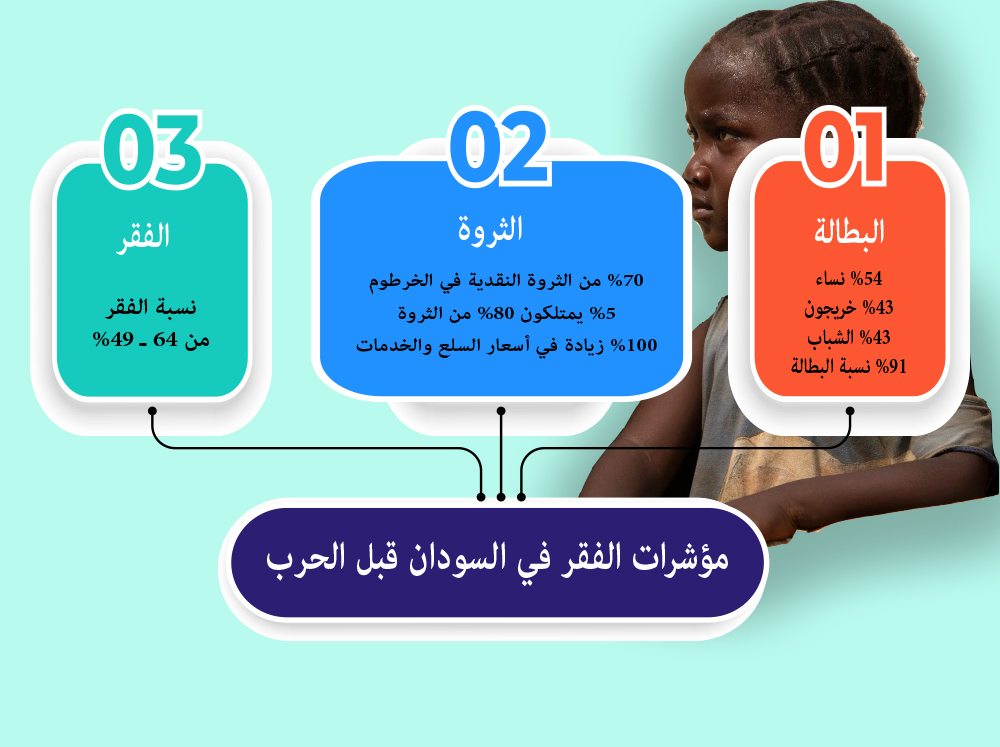
The Fallout of the April War: Increase in Poverty Rates in Sudan
Abdulrahman Al-Ajib
The devastating April War, which has entered its sixth month, has created a new reality in Sudan due to the accompanying displacement, homelessness, and refugees. According to United Nations statistics, Sudan now has the highest number of internally displaced people in the world, estimated at 7.1 million people.
These outcomes, along with the economic and social transformations that occurred in Sudanese society before the war due to the flawed economic policies of the former Salvation regime, have led to an increase in poverty rates in Sudan.
The war that erupted on April 15th between the army and the Rapid Support Forces in the capital Khartoum has extended to nine states: (Khartoum, North and West Kordofan, and the states of South, North, Central, and West Darfur) in addition to the states of Blue Nile and South Kordofan. It has caused displacement and impoverishment of large numbers of citizens in these states.
The Central Statistical Organization, the body responsible for calculating poverty rates, has failed, intentionally or unintentionally, to produce a true percentage of the phenomenon. This has led to conflicting numbers about the real rate over the past years, especially since there are unofficial numbers that have been discussed. In this context, the Sudanese Strategic Report issued by the Center for Strategic Studies in 1997 stated that the poverty rate in Sudan reached 94% of the total population.
While all reports and follow-ups confirm the widening poverty gap, it is noteworthy that statistics on poverty levels in Sudan are still conflicting and unclear, causing controversy among specialists. In this context, United Nations reports indicate that 46.5% of the Sudanese population live below the poverty line, while a government study conducted in 2017 stated that poverty declined to 36.1%.
Meanwhile, economic experts believe that the poverty rate in Sudan reaches up to 80%, according to the economic reality in the country. They attribute this to the decline in all production rates, imbalances, and migration from rural to urban areas, in addition to the exacerbation of unemployment, which is confirmed by the increasing number of people migrating abroad.
The Ministry of Social Security, during the era of the Salvation regime, confirmed that the poverty rate in Sudan reached 46.6%, according to the scientific definition of poverty. The percentage was obtained through a real and scientific survey conducted by the ministry in the past. Hence, it can be said that the poverty rate in Sudan ranges between 46 - 94%.
A previous report by the Zakat Chamber stated that 46% of those who accept Zakat from the poor in Sudan represent a ratio of (3-1000). However, often the Zakat money does not go to the deserving poor and destitute, and it frequently goes to other banks. Sometimes it goes to projects that have no relation to Zakat banks. However, Zakat used to contribute to supporting the poor and destitute and addressing their problems. Nevertheless, this has now stopped due to weak revenues and collections in the states where there is a war.
Previous official data indicates that the unemployment rate in Sudan has risen to 19%, with about 34% among the youth, 48% among graduates, and 45% among women, according to previous official bulletins. A government study predicted a continuous increase in the number of graduates due to the ongoing expansion in higher education institutions, with a slight increase in the annual absorption rates for public sector jobs.
The current reality, created by the devastating April War, indicates a worsening living situation, large segments of society falling into poverty, a lack of job opportunities, and university graduates, civil service employees, and the private sector forced to work in marginal professions.
According to specialists, the most important reasons leading to the spread of poverty in Sudan include the consecutive failure of macroeconomic policies, particularly the policy of economic liberalization adopted by the state since the early nineties, recurring natural disasters such as droughts, desertification, and floods, civil wars, political instability, migration of rural producers to large urban centers, corruption in administration and governance, lack of transparency and accountability, and the failure of agricultural policies related to irrigation problems, high production costs, and farmer insolvency.
Old statistics indicate that 70% of the countrys cash wealth is in Khartoum, the capital of the country, and that about 5% of citizens own more than 80% of this wealth. Perhaps this is reflected in the increase in prices for basic services, including electricity, water, healthcare, and education, which have increased unusually in recent years, often exceeding 100%. Additionally, the prices of necessary and consumer goods have increased. However, there has been no corresponding increase in salaries in the civil service and private sectors.
To combat poverty, some specialists believe that the principles of social justice must prevail in all sectors of Sudanese society. This can only be achieved by not relying entirely on structural economic policies, which see poverty as something exceptional that can be treated on an emergency basis by creating agencies to do so. This should take into account the humanitarian aspects, prioritizing the interests of the weak over the rich. This is the real dimension for the sustainability of society, according to some sociologists who have called on the state to conduct more in-depth and field studies among poor groups, conduct social studies that clarify the conditions they live in and the hardships they endure, and the methods they use to cope with these conditions. This also includes the impact of social poverty on them and the real outcomes of policies supporting them, making the state more scientifically capable of analyzing the social situation more deeply.


